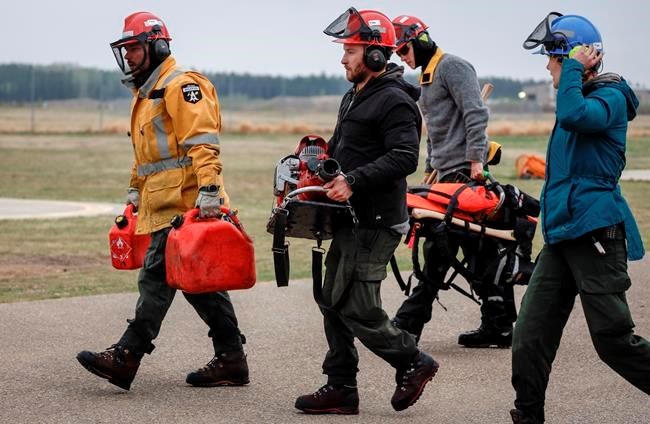Residents of Fort McMurray, Alta., forced to flee their homes earlier this week due to an encroaching wildfire got the green light to head home on Saturday when the municipality governing the oilsands hub lifted all evacuation orders.
The Regional Municipality of Wood Buffalo in northeastern Alberta said weather conditions helped firefighters make progress in battling the blaze that triggered the evacuation of four neighbourhoods on the southern edge of the city — Abasand, Beacon Hill, Prairie Creek and Grayling Terrace.
About 6,600 residents of those neighbourhoods were forced to hastily leave their homes on Tuesday, but a statement from the municipality said firefighters have made considerable progress on the fire since then.
The statement said recent rainy weather helped tamp down the blaze and reduce its intensity, allowing those fighting it to bring it under control and erect fireguards at its northern edge.
"If you've never had the opportunity to see the fire chief dancing in the rain, you missed your opportunity earlier this morning," the municipality's fire chief, Jody Butz, said in a video livestreamed by local and provincial officials.
Evacuation alerts in place for the rest of the community were also lifted on Saturday.
Alberta Wildfire information Officer Josee St -Onge said during the update that about 10 millimetres of rain fell on the area overnight, adding about 20 millimetres has fallen in total since Thursday. More rain is also forecast.
Still, she warned the fire remains classified as out of control.
"While it is safe for evacuees to return, residents will have to live with an active wildfire near their community for weeks if not months," St -Onge said.
The municipality said local highways are open in both directions and emergency social services, including food and accommodation, will remain available until noon on Sunday.
Butz noted returning residents would see red material on trees surrounding their neighbourhoods, which he said is a safe fire-retardant.
"The red colour will slowly fade after exposure to sunlight and some time," he said.
In British Columbia, meanwhile, the Parker Lake and Patry Creek wildfires continue to threaten the northeastern B.C. town of Fort Nelson, which remained under an evacuation order Saturday. The two blazes stood at a combined size of 841 square kilometres as of Saturday morning.
Alerts from DriveBC Saturday said that a wildfire between the beginning and end of Highway 77 had closed the road 138 kilometres south of the border between B.C. and the Northwest Territories.
The Alaska Highway was also closed in both directions for nearly 300 kilometres due to a wildfire burning 94 kilometres north of Fort Nelson, DriveBC said.
In an update posted to Facebook on Saturday, Northern Rockies Regional Municipality Mayor Rob Fraser said minor precipitation Friday helped the firefight, and a camp has been set up to support wildfire personnel.
Fraser said rumours about military involvement in the camp are untrue.
“It looks like a military camp,” Fraser said. “I can see that the rumors might be flying around that the military is out there, but these are our B.C. wild firefighters out there doing what they can for us.”
The mayor also said some of those who have defied the evacuation order have been “hindering” efforts and “causing us some problems,” as the RCMP has had to pull people over “when they should be securing our subdivisions and our houses.”
Hundreds of wildfire evacuees in northwest Manitoba are also being allowed back home soon.
About 675 people from in and around Cranberry Portage who were forced out last weekend can return home as of 10 a.m. Sunday.
Officials said the fire near Flin Flon was about 370 square kilometres in size on Friday, but the fireline closest to Cranberry Portage was under control.
More than 200 provincial personnel are helping to battle the blaze, along with an additional 40 firefighters from Ontario and 20 from New Brunswick who were set to arrive Friday. A further 21 more from Quebec are expected this weekend.
This report from The Canadian Press was first published May 18, 2024.
— With files from Darryl Greer in Vancouver
Rob Drinkwater, The Canadian Press



